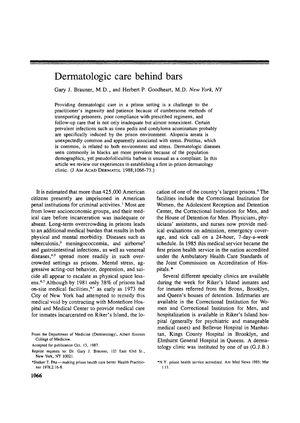Dermatologie care behind bars
May 1988
in “Journal of The American Academy of Dermatology”

TLDR The first in-prison dermatology clinic in the U.S. faced challenges and found certain skin conditions common among inmates, with rare cases of serious skin cancer.
In 1988, Dr. Gary J. Brauner and Dr. Herbert P. Goodheart established the first in-prison dermatology clinic in the United States at Riker's Island, where they encountered challenges such as difficult prisoner transport and poor follow-up care. The clinic, serving a predominantly young black or Hispanic male population, found that certain infections and conditions like tinea pedis, condyloma acuminatum, and alopecia areata were common, with the latter likely related to stress. Over seven years, only three cases of basal cell carcinoma were observed, with no cases of squamous cell carcinoma or malignant melanoma, but two cases of Kaposi's sarcoma in presumed AIDS patients and two cases of mycosis fungoides were noted. Folliculitis was prevalent, possibly due to the use of greases and impermeable head coverings, and an outbreak was linked to a switch to nylon underpants. Surprisingly, pseudofolliculitis barbae was rarely reported despite being common among black males who shave. The prison environment presented significant challenges for dermatologic care, and the high recidivism rate complicated medical record keeping. Additionally, the document briefly mentioned a study on patterned androgenic alopecia in postmenopausal women, suggesting that "male-pattern" hair loss may not be a reliable indicator of androgen metabolism abnormalities.
View this study on jaad.org →